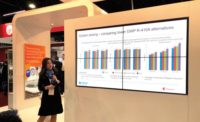There are over a dozen brands of R-410A-based air conditioners and heat pumps available today, and more coming on to the market each season.
R-410A has different physical properties than R-22 and technicians should be aware of the differences. But there are also a number of misperceptions about R-410A. The following is aimed at putting to rest some of the myths about this refrigerant.
Myth No. 1
The higher pressure of R-410A makes it less safe than R-22.Although the pressure of this refrigerant is about 60 percent higher than R-22, the systems, components, service tools, and refrigerant cylinders (both new and recovery) are all designed to safely handle this pressure with a safety margin similar to that for other refrigerants, such as R-22. With over a million R-410A-based air conditioners operating worldwide and nearly a decade of field testing and product history, there is no evidence to suggest that R-410A systems are any less safe than systems that contain R-22.

Myth No. 2
R-410A isn’t the final refrigerant, and there are other refrigerants coming to replace R-22.For new equipment, this is unlikely to be the case. Every major manufacturer of air conditioners and heat pumps in the United States and Japan has introduced R-410A systems or has selected R-410A as the replacement for R-22. Equipment manufacturers selected R-410A after over a decade of research that looked at many different options to meet the criteria for a refrigerant for new equipment. Some of these criteria included:
Myth No. 3
The higher pressures of R-410A cause air conditioners to break down more often.Recent statements by equipment manufacturers indicate this is not only untrue, but that R-410A air conditioners may be remarkably more reliable than air-conditioners that use R-22. There are several factors that appear to contribute to these findings:
Myth No. 4
Cylinders of R-410A are unsafe to carry in your service truck. There is even a warning not to exceed 125?F on the cylinder.This warning appears on nearly all small refrigerant cylinders, including R-12 and R-22. The safety standard has been in place for many years and has been an industry-accepted warning since the earliest days of fluorocarbon refrigerant use. The U.S. Department of Transportation (DOT) establishes regulations for cylinders that contain compressed gases, including liquefied refrigerant gases, and the higher pressure of R-410A was taken into account when the cylinder design was selected.
Proper cylinder handling and storage has always been a prerequisite for safe use of refrigerant gases, and keeping cylinders out of direct sunlight and avoiding poorly ventilated or hot locations have always been a required practices for safe cylinder storage. If any refrigerant cylinders are put into a vehicle for transport, adequate ventilation is necessary to maintain safe temperatures below 125 degrees F.
Myth No. 5
The pressure of R-410A is so high that if your hand gets in the way of a leak, it could cut a finger off.This is a myth, as well as a physical impossibility. Devices such as insulin jet injectors require 7,000 to 10,000 psi pressures to puncture the skin and 16,000 to 25,000 psi pressure spikes are normally used. R-410A does exhibit pressures approximately 60 percent higher than R-22, but these pressures in an operating system will rarely exceed 400 psi.
The refrigerant R-402A is one of the most widely used refrigerants used in commercial refrigeration and exhibits pressures more than 30 percent higher than R-22, but experienced refrigeration contractors have learned that this makes little difference in the safety of the product in day-to-day usage.
It is good practice to never place any body part or object in the path of a leaking pressurized gas, no matter the leak rate or pressure.
Myth No. 6
The lubricants used with most R-410A systems will absorb so much moisture that if you fill a glass half-full with POE oil and come back an hour later, the glass will be half full of water.This is another myth. Although polyolester (POE) oils used in most R-410A systems are more hygroscopic, or water-absorbing, than mineral oils, the typical POE oil becomes fully saturated with water at 0.2 percent to 0.3 percent, which is not enough to notice when visually inspecting a container of the lubricant.
Should moisture get introduced into an R-410A based system, the filter-drier is designed to remove this moisture before it can react and create harmful acids, which is why these devices are almost universal on R-410A systems. The advertised reliability of new R-410A systems compared to new R-22 systems indicates that this approach has been successful. Even so, steps should be taken to reduce moisture contamination and therefore extend the life of the filter-drier.
For example, it is theoretically possible for moisture to be absorbed into POE oil through a thin wall of certain types of plastic, which is why contractors are advised not to store POE oils in plastic containers. Most equipment manufacturers have their own guidelines for how long an R-410A-based system should be left open to the air in order to limit the absorption of moisture, and these guidelines should be followed to maintain warranties.
Mark Spatz is manager, Refrigerant Technical Services and David Metcalf is marketing manager, both for Honeywell’s Genetron® Refrigerants.
Publication date: 02/03/2003




